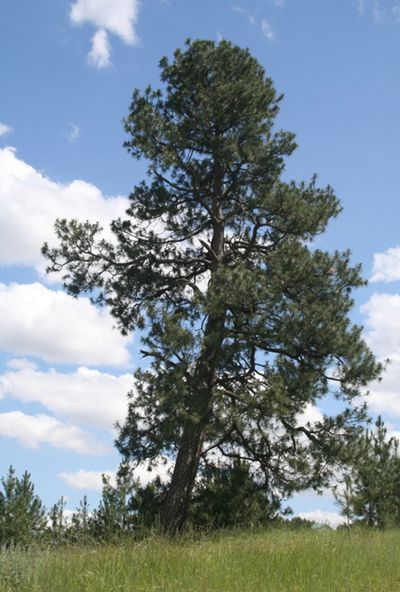Landmarks: Treaty Tree on Peone Prairie still stands

A lone pine tree stands atop a grassy knoll just south of Doak Road, near where it intersects with Argonne Road on Peone Prairie. And although it looks like just any other ponderosa pine, its documented history dates back to the mid-19th century.
It is the Treaty Tree, sometimes called the Conference Tree or the Signal Tree, a historic witness to the relationship between the Spokane Tribe and the American military in the 1800s. There are some things not precisely known about the tree, but what is documented is what happened at the tree and the likely time period in which it happened.
It all began when Baptiste Peone, the chief of the Upper Spokane band of the Spokane Tribe, was chosen by the Hudson’s Bay Co. to locate a trading post along the trail between Fort Colville and Lake Coeur d’Alene, probably in the late 1840s. He built his post at the southeast edge of a prairie near a spring a few miles northeast of what is now Spokane. The prairie has since borne his name: Peone Prairie.
His band remained mostly peaceful during the Indian wars of 1855 and 1858, and when the various tribes signed peace treaties with Col. George Wright, most accounts note that Peone placed a truce flag atop the lone pine tree near his camp – and that the flag stayed in place for 22 years, finally disintegrating into tatters, the victim of time and weather. That tree became known as the Treaty Tree.
Leaning noticeably to the south, the tree has a distinct hollow core about 5 feet tall at its base, believed to have been caused by fire. Although the source of the fire is unknown, a 1923 article in the Spokane Chronicle notes that lightning from a thunderstorm the previous summer struck the tree, scarring the bark.
Early photos show the cavity wider than it is today. “The cleft is trying to close, and the tree is trying to heal itself,” said local tree expert Dr. Ed Lester, a retired orthopedic surgeon whose passion for area trees has led him to a second career as an author on the subject (“Champion and Historic Trees of the Inland Northwest”).
The tree is not especially tall by ponderosa pine standards, but Lester notes that ancient ponderosas aren’t necessarily tall. Size often has to do with growing conditions. The tallest ponderosa in America is in Plumas, Calif., and stands at 223 feet. The tallest one in Washington is 213 feet tall and is located near Mount Adams. Lester said the Treaty Tree is 80 feet tall and 40 feet across at the crown.
Its exact age is harder to determine without a core sample. It was already described as a tall tree in the mid-1800s when its role in history was established, so Lester said it’s quite possible that the tree dates back as early as the late 1700s.
The Treaty Tree and its flag also bore witness to the coming to the prairie of the Rev. Joseph Cataldo, a Jesuit missionary for whom Peone erected a small cabin in 1866, which served as a camp house, rectory, church and school. It was dedicated to St. Michael in a ceremony described in the 1923 Spokane Chronicle article as “the first religious ceremony held in a regularly ordained house of worship in Spokane County.”
Over the years, other Jesuits came to the area and built several mission schools, known at St. Michael’s Mission, which exists today as Mount St. Michael, home to the Congregation of Mary the Immaculate Queen, a traditional Latin Rite congregation which has a parish, convent and school on the property overlooking the prairie. And Cataldo went on to found a Jesuit institution of higher education – today’s Gonzaga University.
Everything did not remain peaceful on the prairie, especially as white settlers flooded the area, and in 1887 a new treaty required the Indians to leave their lands and move to the Coeur d’Alene or Flathead reservations. (Peone went to the Flathead Reservation, in Montana, where it is believed he died in 1902.) Some say the flag was put high in the tree to commemorate the 1887 treaty, but most evidence points to the earlier date.
The tree’s significance has been noted, and an effort was made to preserve it in the form of a clause in the land deed of 1923 that declares that “no hand of man shall harm the treaty tree.” There remains scant tangible evidence of Chief Peone and the missionaries on the prairie, as the cabins and other structures are long gone.
But the Treaty Tree still stands.